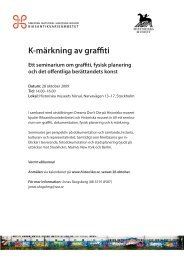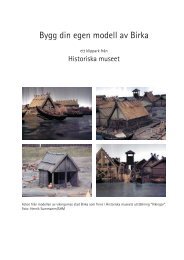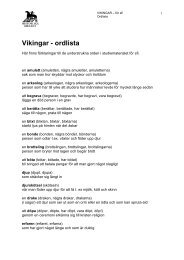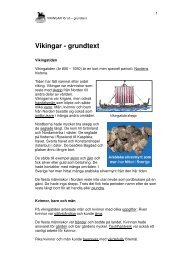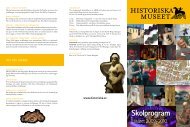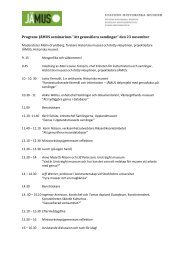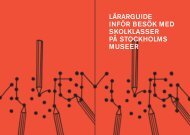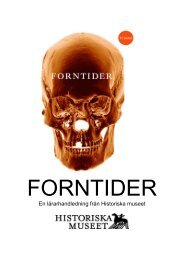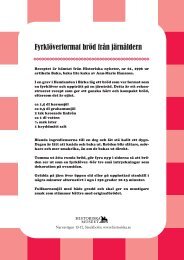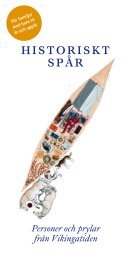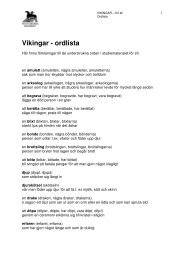1 2 3 4 5 6 0 - Historiska museet
1 2 3 4 5 6 0 - Historiska museet
1 2 3 4 5 6 0 - Historiska museet
Create successful ePaper yourself
Turn your PDF publications into a flip-book with our unique Google optimized e-Paper software.
Travelling exhibition
Content 01<br />
About the exhibition & the Team 02<br />
Themes 03<br />
Route guidance - Belt of sources 04<br />
0 - Introduction - Europe 750 to 1100 05-06<br />
Theme 1 - Making the Viking 07-08<br />
Theme 2 - Homes, Colourful and Bustling 09-10<br />
Theme 3 - More than just Worship 11-12<br />
Theme 4 - The Living and the Dead 13-14<br />
Theme 5 - Made by Vikings 15-16<br />
Theme 6 - Away on Business 17-18<br />
7 - Viking ship 19<br />
Basic data 20<br />
Images 21<br />
About us and Contact 22
Team:<br />
About the exhibition 02<br />
Peter Elsässer, Siegfried Brugger, Sales Manager, MuseumsPartner<br />
Katty Hauptman Wahlgren, Project Manager, Statens <strong>Historiska</strong> Museum, Stockholm<br />
Maria Christina Zingerle, Concept Manager, studio exhibit<br />
Gunnar Andersson, Scientifi c Expert, Statens <strong>Historiska</strong> Museum, Stockholm<br />
Petter Ljunggren, Educational Expert, Statens <strong>Historiska</strong> Museum, Stockholm<br />
Oliver Pfeiler, Exhibition Designer, studio exhibit<br />
Ulrik Skans, Senior Conservator, Statens <strong>Historiska</strong> Museum, Stockholm<br />
Sophie Nyman, Head of Exhibitions and Learning, Statens <strong>Historiska</strong> Museum, Stockholm<br />
„we call them Vikings“ challenges our picture of<br />
the Viking Age.<br />
What do we really know about the people we call<br />
Vikings?<br />
More than a thousand years ago Viking culture<br />
was advancing, and the Viking Age has become<br />
a mythical period in Scandinavia. But the world<br />
of the Vikings has changed as a result of the<br />
archaeological discoveries of recent years.<br />
Who were they, how did they live and what did<br />
their world look like?<br />
These are some of the questions you will fi nd<br />
answers to in a modern exhibition that is based on<br />
new archaeological fi ndings and interaction with<br />
the museum visitors.<br />
Their story is told with the help of a large number of<br />
unique objects from <strong>Historiska</strong> <strong>museet</strong> in Stockholm,<br />
objects that have rarely been shown outside<br />
Scandinavia.<br />
Six different themes in the exhibition give insights<br />
into domestic life, death rituals, the signifi cance of<br />
craft, the power of mythology and the symbolism<br />
of the Viking ships.<br />
Trite stereotypes are removed and the Vikings<br />
manifest themselves in a new, more nuanced and<br />
fascinating light than ever.
5<br />
Themes 03<br />
0 - Introduction - Europe 750 to 1100<br />
Theme 1 - Making the Viking<br />
Theme 2 - Homes, Colourful and Bustling<br />
Theme 3 - More than just Worship<br />
Theme 4 - The Living and the Dead<br />
Theme 5 - Made by Vikings<br />
Theme 6 - Away on Business<br />
7 - Optional - Viking Ship<br />
4<br />
6<br />
7<br />
3<br />
0<br />
2<br />
1
Route guidance 04<br />
„Belt of sources“<br />
The exhibition starts with the Belt of sources, which in the Introductory zone<br />
contains a general introduction to the exhibition. The Belt of sources<br />
continues as a companion for the visitors bracing the exhibition by offering<br />
archaeological and written sources relevant for the Viking Age together<br />
with the displayed exhibits, in addition to seats for short rests.
Charles I (Charlemagne)<br />
Europe in 814<br />
Cyrillic Alphabet<br />
Bayeux tapestry:<br />
Norman conquest of England<br />
0 - Introduction 05<br />
Europe, a construction area<br />
What happened between 750 and 1100 in what we know as Europe?<br />
The exhibition deals with the period between 750 and 1100<br />
in Scandinavia. Contemporary events in other parts of Europe<br />
are used to act as comparison to the surrounding world<br />
of the Vikings.<br />
Traditionally the start of the „Viking Age“ has been set to<br />
8 June 793 when plundering Vikings attacked the monastery of<br />
Lindisfarne. But it is not altogether easy to date the „Viking Age“.<br />
Different time frames appear depending on the studied material.<br />
There is also clear evidence that contacts with the continent<br />
and the British Isles stem from a much earlier date than the Viking<br />
Age.<br />
„Belt of sources“:<br />
* Introduction to the exhibition<br />
* The „Belt of sources“ is introduced to the visitors as a companion<br />
through the exhibition.<br />
* Beginning and end of the ”Viking Age”<br />
as a historical and archaeological construction.
Otto the Great<br />
2nd Crusade to Jerusalem<br />
Scandinavian routes<br />
Monastery of Lindisfarne<br />
0 - Introduction 06<br />
Europe 750 to 1100<br />
We know that Scandinavian travellers took home both goods<br />
and important information about conditions and opportunities<br />
in foreign counties many centuries before the „Viking Age“.<br />
During the Viking Age encounters sometimes grew into armed<br />
confl icts. The causes can to a large extent be traced to<br />
domestic politics in the realms of the Franks and in England.<br />
Design:<br />
Eight events, dates and personalities important for European<br />
history (including Scandinavia) between 750 and 1100 will be<br />
displayed. Large-screen panels hanging on a „scaffolding“-like<br />
construction underline the character of a building site.
Theme 1<br />
Making the Viking<br />
We do not really know what the name „Viking“ stood for<br />
But we do know that the Vikings were not a national entity.<br />
The word “Viking” was used already during the Viking Age,<br />
sometimes with reference to things that people did:<br />
“being out as a Viking” or “acting like a Viking”.<br />
At other times it seems to have referred to a person,<br />
or rather a person’s surname.<br />
In the exhibition we have chosen to defi ne the Viking as a<br />
person from Scandinavia involved in plundering,<br />
trade or colonization.<br />
The Viking was commonly a man. Although there are a few<br />
examples, women, slaves (‘thralls’) and children were rarely<br />
Vikings.<br />
„Belt of sources“:<br />
*Maps<br />
*Start date of the Viking Age, 750: Anglo-Saxon_Chronicle<br />
*Norse sources: ordinary people are referred to as norroenar<br />
or norroenir menn (‘Norrön men’).<br />
07
Theme 1<br />
Making the Viking<br />
„Vikings” and other people during the Viking Age<br />
In the Norse sources, ordinary people are referred to as Norroenar.<br />
When introducing themselves, they would probably have used the<br />
name of the farm, estate, village or area where they lived.<br />
Nowadays the Viking Age is synonymous with Viking raids for many<br />
people. Traditionally the raids are shown as being conducted only<br />
by men, often wearing horned helmets.<br />
Although they are only a fi gment of our modern imagination these<br />
helmets are probably the most well-known Viking Age stereotype.<br />
But the mythical Viking raider is not a fi gment pure and simple,<br />
as long as we realize that most Scandinavians during the Viking<br />
Age were never Vikings. On the contrary, the Vikings seem to have<br />
been feared at home as well as abroad.<br />
Design:<br />
A “table”, shaped like a “ship” with 5 “bows” (front part of a ship),<br />
symbolises the art of being capable of navigating in every<br />
direction. On the table area the word “Vikings” is engraved with<br />
large letters. Pictures and maps (geographical, historical maps, ...)<br />
of Scandinavia will be projected across the „Vikings“<br />
engraving. Screens for texts and showcases are placed around<br />
the sides of the table.<br />
Projection<br />
08
Projection<br />
Theme 2<br />
Homes, Colourful and Bustling<br />
The daily life a multicoloured and animated mosaic<br />
The domestic environment was colourful and anything but grey,<br />
colourless and harsh, as one might otherwise be led to believe.<br />
The well-situated people had ornaments of glossy bronze,<br />
weapons of burnished steel and artistically ornamented combs<br />
that they wore together with their clothing.<br />
Textile fragments from graves show that even in simple agrarian<br />
environments, not only wool but silk and linen too were<br />
available.<br />
Textiles were generally dyed with plant materials and dyes were<br />
based largely on regional fl ora.<br />
Pigment analyses of runes and pictorial stones reveal that these<br />
too were colourfully painted.<br />
„Belt of sources“:<br />
*Maps<br />
*Archaeology about settlements<br />
*”Rigstula”, the social structure of the ”vikings”<br />
09
Theme 2<br />
Homes, Colourful and Bustling<br />
Strong women managing the Viking Age farms<br />
The houses belonging to the single farms were often up to<br />
20 metres long and built in accordance with a building tradition<br />
that was several hundred years old.<br />
The Viking Age free women were responsible for the management<br />
of the farms. The farm was the very centre of the Viking Age world<br />
and consequently of the utmost importance. Free women enjoyed<br />
greater equality than the Christian women of later generations.<br />
Viking Age farms, villages and “towns”<br />
Settlement patterns varied in different parts of the homelands.<br />
In some areas the usual pattern was one of farmland<br />
concentrated in villages, while in others single farms were the norm.<br />
At the beginning of the Viking Age a new settlement pattern appears<br />
in many places in Scandinavia: towns started to appear.<br />
Design:<br />
Scandinavian ”long house” - the „outer walls“ have a pattern of<br />
a mosaic containing images, texts, showcases relating<br />
to Scandinavian-Viking Age living, and a movie about the famous<br />
and well studied town ”Birka”.<br />
”Inside” the long house at the left narrow side a projection<br />
implies the life in a viking house with images and sounds of<br />
people working, cooking, children, dogs, etc.<br />
10<br />
Projection
Theme 3<br />
More than just worship<br />
Religious transition<br />
During most of the Viking Age people in Scandinavia combined two<br />
very different religious systems: the domestic Old Norse religion and<br />
Christianity.<br />
The two systems seemed to have blended into a kind of hybrid, as<br />
can often be inferred from existing graves. Religion may in those<br />
days not have been such a “great watershed” between people as<br />
it later became. “White Christ” was from the Viking point of view not<br />
hard to accept; the crux was rather how his doctrine affected the<br />
everyday side of life.<br />
But by the end of the Viking Age Christianity dominated in<br />
Scandinavia and by 1100 AD it was the only offi cial religion in<br />
Scandinavia.<br />
„Belt of sources“:<br />
*Maps<br />
*Written and archaological sources:<br />
cemeteries, Snorre Sturlasson‘s Edda.<br />
Projections<br />
11<br />
Multitouch-table with a boat-grave
Theme 3<br />
More than just worship<br />
The old custom<br />
The Old Norse religion cannot be compared with a “religion”<br />
in the conventional Western sense of the word. Instead,<br />
the expression used in the sources is forn siðr, i.e. “old custom”.<br />
This old custom related to all aspects of life and death and<br />
consequently to a great deal more than just the worship of deities.<br />
But, there are no contemporary sources that describe people’s<br />
religious beliefs and customs. The most coherent report on religion<br />
in the Norse area was produced in 1220-30 by the Icelandic chief<br />
and poet Snorre Sturlasson in a document known as the prose<br />
Edda. According to Snorre, the supernatural world was populated<br />
by two different mythological beings: gods and giants.<br />
Design:<br />
The huge circles symbolises the closely intertwined existence of<br />
both of the beliefs which nevertheless went side by side.<br />
The outer circle represents Old Norse religion,<br />
the inner circle the Christianity.<br />
Both of the circles have interactive elements and projections.<br />
Behind and slightly hidden the „Religious transition“.<br />
The „Belt of sources“, in this area corresponding to the „divine“<br />
theme, is slightly elevated and bears showcases and the<br />
corresponding written and archaeological sources.<br />
„Religious transition“<br />
12
Theme 4<br />
The Living and the Dead<br />
Graves express various symbols and meanings<br />
The dead continued to belong to the farm household and<br />
“lived on”, but in the mound or the mountain rather than in the<br />
house itself.<br />
Thus the cemeteries were living places near the family<br />
settlement that were used for many other purposes than burials.<br />
These ideas have a distinctly popular touch and are not<br />
mentioned in the “aristocratic” Edda and Norrön poetic<br />
literature.<br />
In the poetic Edda we meet instead the aristocratic kingdoms of<br />
the dead, the most famous of which is Valhall. Valhall is Oden’s<br />
hall, where he receives half the fallen warriors selected by the<br />
Valkyries.<br />
„Belt of sources“:<br />
*Maps<br />
*Ibn Fadlan’s report about the burial ceremony<br />
of a Rus-Viking chief<br />
* The poetic Edda and poetic literature:<br />
aristocratic kingdoms of the dead.<br />
*Archaeology<br />
13<br />
1200 hanging rivets of a boat
Theme 4<br />
The Living and the Dead<br />
Individualistic and collective mentality<br />
In contrast to the Christian approach, which was<br />
unequivocally individualistic, pre-Christian mentality was<br />
more centered on the collective.<br />
You could count on a good life in the hereafter if you in this<br />
life embraced values that benefi ted your own family, kinship<br />
or warrior collective.<br />
As regards the warrior aristocracy, an honourable death on<br />
the battlefi eld gave credit while a natural death on the farm<br />
was anything but glorious.<br />
Design:<br />
A multi-touch-table carries the documentation of a boat grave,<br />
placed between the „gods“ and the „death“.<br />
A ribbon-like gateway encompasses 1200 rivets of a boat,<br />
representing an aristocratic boat grave contrasted with a grave<br />
of an „ordinary person“. A sophisticated light-setting casts a<br />
(moved) shadow of the 1200 rivets on the fl oor of the gateway.<br />
By „walking through“ the gateway the visitor is reminded of the<br />
connection between the living and the dead among the Viking<br />
Age people.<br />
14
Theme 5<br />
Made by Vikings<br />
Craftsmen, polyvalent and skillful<br />
A typical element of craftsmanship was the ability to transform<br />
fi nished products acquired from foreign countries.<br />
Such objects originally had a certain function, but assumed a<br />
different signifi cance in Viking Age culture.<br />
Craft, especially metal craft, had metaphysical and<br />
mythological signifi cance. It is stated in Völvan’s Prophecy that<br />
the Aesir/gods forged metal.<br />
Forging in this context means “creating” or “making”.<br />
The gods were regarded as craftsmen in one sense or other and<br />
refi nement of metal as a way of changing the world as created<br />
by the gods.<br />
For this reason craftsmen also had to master the rituals that<br />
controlled certain forces in the world.<br />
„Belt of sources“:<br />
*Maps<br />
*Runes and rune stones<br />
*Archaeology<br />
*Myths about the craftmen<br />
15
Theme 5<br />
Made by Viking Age craftsmen<br />
The craftmanship<br />
Viking craftsmen used many different materials, for example<br />
textiles, metal (wrought iron and steel and precious metal),<br />
wood, bone and horn, leather, glass and pottery.<br />
They were skilful and had great knowledge when it came<br />
to the best way of working up their raw material.<br />
Their craft was the result of ancient learning and traditions.<br />
Carving and deciphering runes was also a part of a tradition<br />
going back several hundred years.<br />
Runes were generally used for inscriptions on large stones and<br />
on various portable wood or bone objects. But as far as we<br />
know they were not used for inscriptions on paper or parchment.<br />
Design:<br />
In the center the craftsmen and their resources<br />
(tools, raw material, myths…).<br />
Outside the results of their work (objects, originally Scandinavian<br />
or transformed, …) looking back to the center as if they were<br />
asking „who made us“?<br />
The belt of sources is getting wider offering a platform<br />
to show and discuss the skills of the craftsmen and their goods.<br />
16
Theme 6<br />
Away on business<br />
Ships - the key to a Viking journey<br />
The Vikings were capable of navigating the seas without<br />
instruments and navigation calculations.<br />
Instead, they used knowledge about winds, tidal currents,<br />
weather phenomena and travelling times accumulated<br />
by many generations of ancestors.<br />
Ships were the key to the Vikings’ journeys over the seas<br />
and a strong symbolic element of the age,<br />
and this is also borne out by the many ‘kennings’ – poetic<br />
circumlocutions – for ships that occur in<br />
Norse poetic literature.<br />
‘Havets häst’ (Seahorse), ‘Våghäst’ (Wavehorse),<br />
‘Segelhäst’ (Sailhorse) and ‘Havets skida’ (Seaskis)<br />
are some common examples.<br />
„Belt of sources“:<br />
*Maps<br />
*Runes, rune stones, Picture stones of Gotland<br />
*Greenland Saga; Ingvar Saga, ...<br />
*Archaeology: ships of Gokstad, Oseberg, Äskekärr, ...<br />
*Viking‘s shipbuilding<br />
17
Theme 6<br />
Away on business<br />
Expedition - looting - colonisation - shipwreck<br />
Even if contacts with the continent occurred earlier,<br />
the world of the Scandinavians expanded considerably<br />
during the Viking Age.<br />
The Viking Age offered plenty of scope for cultural<br />
and new infl uences.<br />
Riches and exclusive articles such as luxury objects,<br />
cloth and clothing, but perhaps most of all silver,<br />
fl owed into Scandinavia.<br />
We do not know how much derived from legitimate trade<br />
and how much from plunder. Both activities were probably<br />
closely interconnected.<br />
We should also remember that not all journeys ended as<br />
planned. There were doubtlessly many shipwrecks,<br />
especially in the open sea.<br />
Design:<br />
A skeleton of an abstract ship has both front and back.<br />
It implies the ability to navigate in two directions, i.e. „go on viking“<br />
and come back home.<br />
The skeleton carries screens for text, showcases and graphic elements.<br />
An interactive module shows the Vikings’ shipbuilding skill.<br />
18
7 - Viking ship<br />
Optional:<br />
“The Viking ship”:<br />
A true-to-scale and authentic reconstruction of a<br />
“Viking ship” can be part of the exhibition.<br />
The vessel actually navigated several times along<br />
the rivers of the Viking Age commercial routes to<br />
the black sea.<br />
Films recorded their journeys and adventures.<br />
Like a new route now the ship escorts the exhibition<br />
“We Call them Vikings”. For visitors it is even<br />
possible to enter the Viking ship.<br />
With lack of space for the large ship a<br />
reconstruction of a smaller “Viking ship” from a<br />
boat grave can be offered.<br />
19
Basic data<br />
Exhibits:<br />
<strong>Historiska</strong> Museet -<br />
The Museum of National Antiquities Stockholm, Sweden,<br />
with one of the largest exhibition from the Viking Period<br />
in the world<br />
About 300 unique objects, rarely shown outside Scandinavia<br />
Exhibition size:<br />
From 650 sqm fl oor space up to 1.000 sqm fl oor space<br />
Flexible modular design-system<br />
The exhibition will be bilingual (English and your own language)<br />
Turnkey delivery service<br />
1st exhibition opening: Year 2011<br />
Loan periode: Minimum of 3 month’s / venue<br />
Maximum of 6 month’s / venue<br />
Merchandising<br />
Catalogue<br />
20
Images<br />
02 - Statens <strong>Historiska</strong> Museum, Stockholm<br />
04, 05, 06 - http://commons.wikimedia.org<br />
07 - 18 Exhibits: Statens <strong>Historiska</strong> Museum, Stockholm<br />
07 - 18 Pictures: http://commons.wikimedia.org<br />
19 - Statens <strong>Historiska</strong> Museum, Stockholm<br />
05 - 20 Renderings: Virtual DynamiX, Vienna www.vdx.at<br />
21
Katty Hauptman Wahlgren<br />
Gunnar Andersson<br />
Petter Ljunggren<br />
Ulrik Skans<br />
Sophie Nyman<br />
Peter Elsässer<br />
Siegfried Brugger<br />
Maria Christina Zingerle<br />
Oliver Pfeiler<br />
About us and Contact<br />
Statens historiska museum, Stockholm<br />
<strong>Historiska</strong> <strong>museet</strong> is one of Sweden’s largest museums with<br />
a unique collection of archaeological artifacts from Sweden.<br />
The permanent Viking exhibition and the Gold Room display<br />
original objects from the Scandinavian Iron and Viking Ages,<br />
including many key objects from the periods and gold treasures<br />
from what is known as Scandinavia’s Gold Age.<br />
Information in English about <strong>Historiska</strong> <strong>museet</strong> / The Museum of National Antiquities<br />
www.shmm.se<br />
MuseumsPartner, Innsbruck - Vienna<br />
www.museumspartner.com<br />
studio exhibit, Vienna<br />
www.museumspartner-exhibit.com<br />
Our experience and educational skills lie in communication with the<br />
museums; the sales management of exhibition and turnkey<br />
exhibition management, Peter Elsässer and Siegfried Brugger<br />
(MuseumsPartner);<br />
in formal composition and in design, Oliver Pfeiler (studio exhibit);<br />
and the concept development of scientifi c contents for exhibitions,<br />
MariaChristina Zingerle (studio exhibit).<br />
22<br />
Contact content and objects:<br />
Katty Hauptman Wahlgren<br />
katty.wahlgren@historiska.se<br />
+46-8-51 95 56 70<br />
Contact sales and bookings:<br />
Peter Elsässer<br />
elsaesser@museumspartner.com<br />
+43-512-562 80 00<br />
+43-664-210 06 73<br />
Siegfried Brugger<br />
brugger@museumspartner.com<br />
+43-512-562 80 00<br />
+43-650-401 19 10<br />
Contact production and design:<br />
M.Christina Zingerle<br />
zingerle@museumspartner.com<br />
+43-1-47 88 553<br />
+43-650-59 59 759



